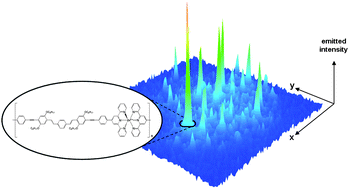Fluorescence quenching in Zn2+-bis-terpyridine coordination polymers: a single molecule study†
Abstract
A Zn2+-bis-terpyridine coordination

* Corresponding authors
a
Institute for Physical Chemistry, Jena Center for Soft Matter (JCSM), Abbe Center of Photonics (ACP), Friedrich-Schiller-University Jena, Helmholtzweg 4, 07743 Jena, Germany
E-mail:
benjamin.dietzek@uni-jena.de
b
Department of Chemical Physics, Lund University, P.O. Box 124, 22100 Lund, Sweden
E-mail:
ivan.scheblykin@chemphys.lu.se
c Laboratory of Organic and Macromolecular Chemistry (IOMC) and Jena Center for Soft Matter (JCSM), Friedrich-Schiller-University Jena, Humboldtstr. 10, 07743 Jena, Germany
d Dutch Polymer Institute (DPI), P.O. Box 902, 5600 AX Eindhoven, The Netherlands
e Institute of Photonic Technology (IPHT) Jena, Albert-Einstein-Str. 9, 07745 Jena, Germany
A Zn2+-bis-terpyridine coordination

 Please wait while we load your content...
Something went wrong. Try again?
Please wait while we load your content...
Something went wrong. Try again?
R. Siebert, Y. Tian, R. Camacho, A. Winter, A. Wild, A. Krieg, U. S. Schubert, J. Popp, I. G. Scheblykin and B. Dietzek, J. Mater. Chem., 2012, 22, 16041 DOI: 10.1039/C2JM31237A
To request permission to reproduce material from this article, please go to the Copyright Clearance Center request page.
If you are an author contributing to an RSC publication, you do not need to request permission provided correct acknowledgement is given.
If you are the author of this article, you do not need to request permission to reproduce figures and diagrams provided correct acknowledgement is given. If you want to reproduce the whole article in a third-party publication (excluding your thesis/dissertation for which permission is not required) please go to the Copyright Clearance Center request page.
Read more about how to correctly acknowledge RSC content.
 Fetching data from CrossRef.
Fetching data from CrossRef.
This may take some time to load.
Loading related content
